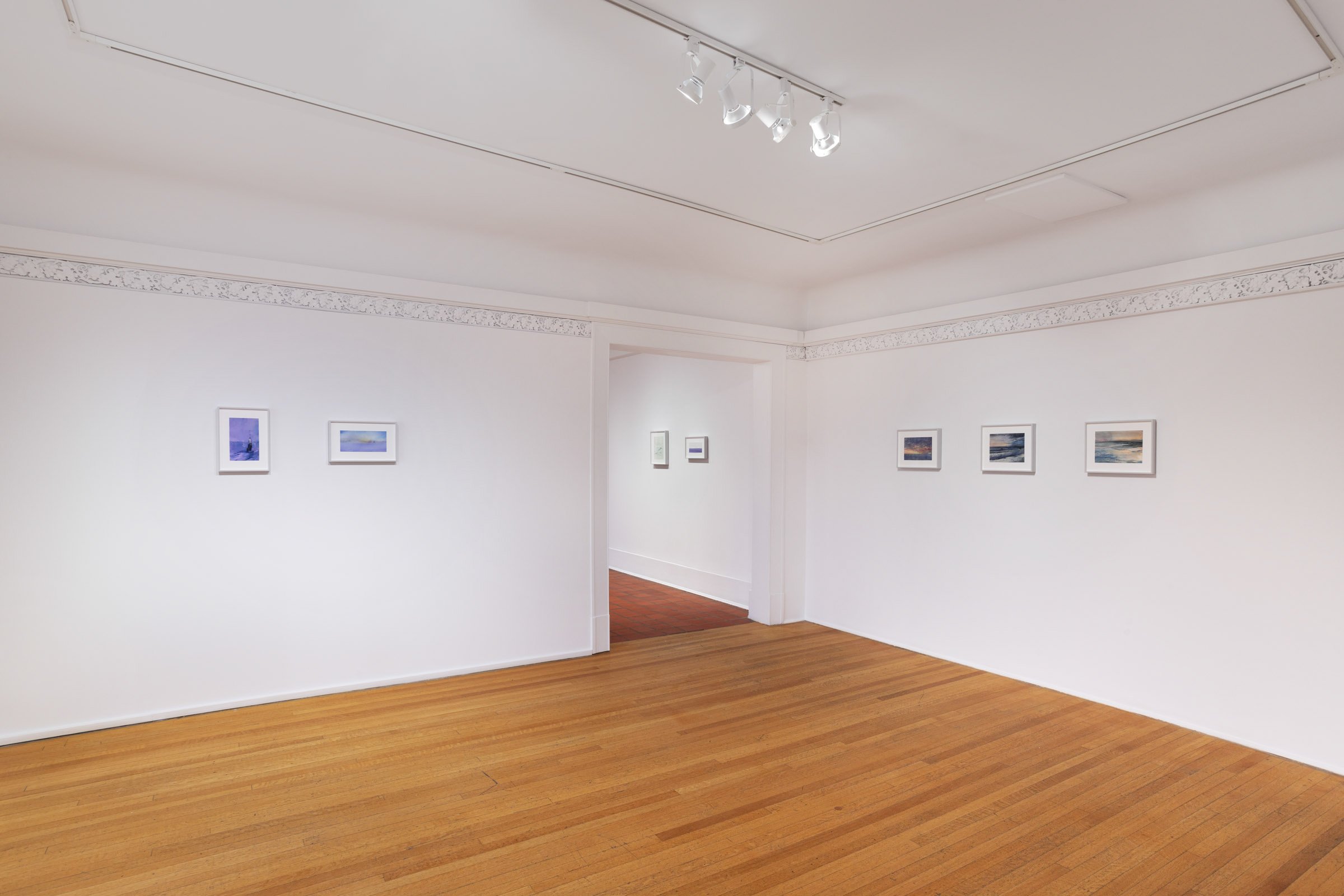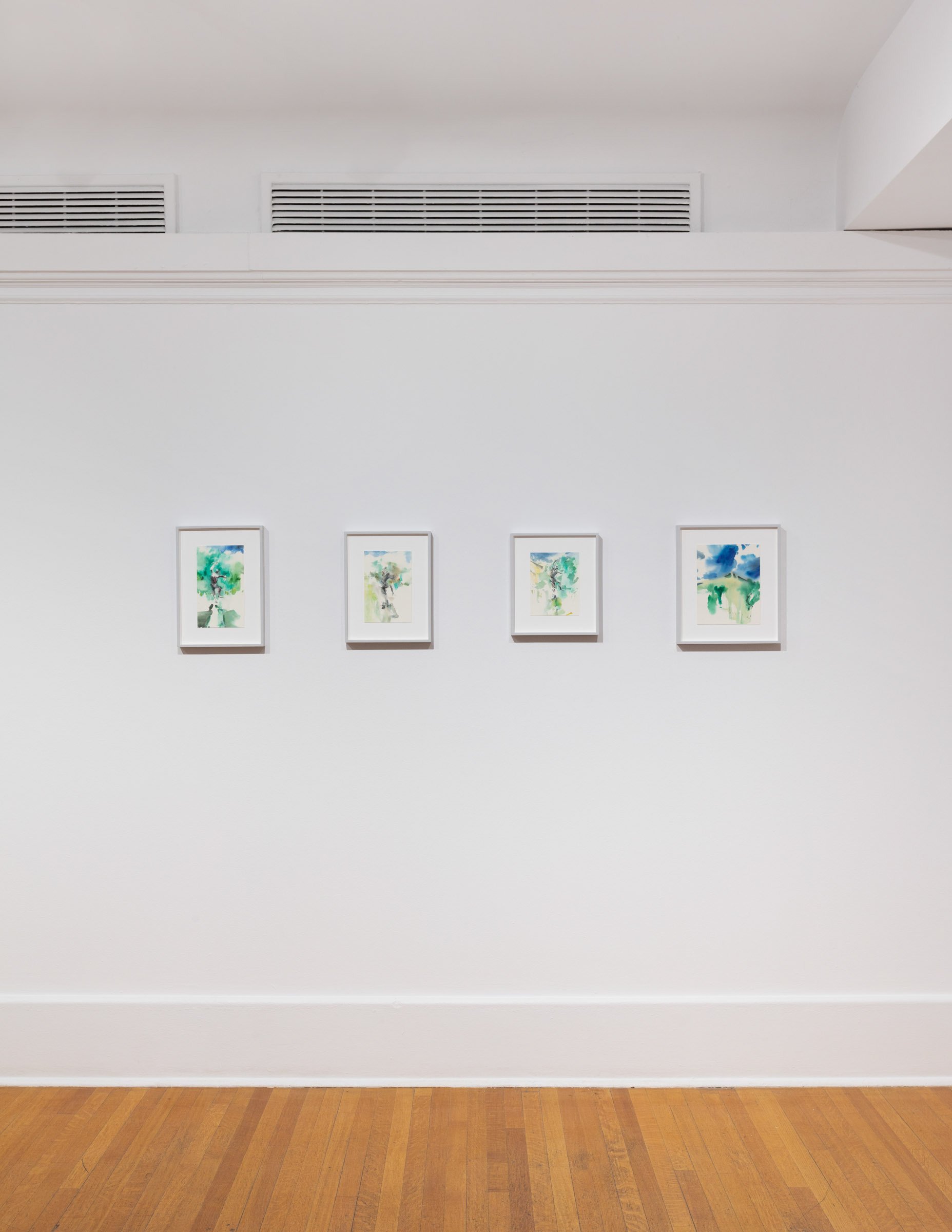If You Blink, You Might Miss It
The Cipher Paintings of Paul P.
Paul P. Untitled, 2019, installation view, Paul P: Friendly in the Knife-edged Moment, 2022, Oakville Galleries. Courtesy of Oakville Galleries. Photo: Laura Findlay.
You know the feeling of encountering a boundary of desire and quietly crossing it? That’s the experience of Paul P.’s exhibition Friendly in the Knife-edged Moment at Oakville Galleries in Gairloch Gardens. The exhibition showcases five intimate paintings and several watercolor and ink drawings created over the past twenty years but never publicly exhibited until now. In these works, the artist weaves together threads of history, memory, and longing linking the past with the present from a visual repertoire of idyllic landscapes, flowers, and male youths.
At a quick glance, P.’s sketches might seem old-fashioned or conservative compared to Oakville Galleries’ regular ultra–avant-garde fare. "Who is this Sunday painter?” you might scoff. According to P., such inauspicious first impressions are intentional; he describes his paintings as “operating as decoys to speak on other ideas surrounding queerness, temporality, and social issues.”1 This is a time-honored queer strategy of hiding in plain sight under the guise of being anachronistic or out-of-fashion. But further looking and investigation of P.’s motifs unveils a latent queer subjectivity, one that revels in an out-of-sync relationship to the present to sing of past poetics and visual ciphers.
P.’s watercolors — the majority of the exhibition — are scarcely mere studies for grander renderings of an idea in oil. Instead, these envisage a dreamy, fragmented nature all their own. An ensemble cast of images, not an elite of protagonists privileged over various supporting actors, populate P.’s visual world.
Paul P: Friendly in the Knife-edged Moment, 2022, installation view, Oakville Galleries. Photo: Laura Findlay. Courtesy of Oakville Galleries. Photo: Laura Findlay.
The four small, closely cropped portraits of young men that greet you on entering the space will feel familiar to those who know P.’s oeuvre. They intimately zoom in on the haunting and cryptic faces of these youths in a painterly accretion of ambiguity. For decades, the artist has turned to Canada’s ArQuives (one of the world’s largest LGBTQ2+ archives) for source material, taking special interest in its collection of 1960s and 1970s gay pornography. Even as transformed through the facticity of paint, these images and their origins lend the paintings a foundational eroticism; the finished works remain “tethered to that original desire” even as they move into other spaces.[2] P.’s sensitivity toward the painting’s edge, what gets into and what remains outside the composition, is crucial here.
Source material aside, there is also something inherently queer about the images, specifically how they operate outside of time. Formally, P. aligns his painting sensibility with the late nineteenth and early twentieth century realism of John Singer Sargent, James McNeill Whistler, and Joaquín Sorolla y Bastida. But the erotic source material is all P.’s own and acutely of his post-modern moment. His references date to a golden age in queer history bracketed by Stonewall in the late 1960s and the beginning of the HIV/AIDS epidemic some twenty years later. This period had already largely passed as P. came into his own in the late 1980s. The explicit content at the works’ erotic origins is deliberately veiled and coded through P.’s insistence on moving in and cropping the head of these youths. He paints them with a flourish of historical sensibility all while keeping them salaciously charged with desire. There is no easy reconciliation between the works’ explicit origins and P.’s transformative historical bravura. Instead, their tension reverberates as an uncanny anachronism. His painterly affect suspends his subjects in time, on the very precipice of youthful folly as dark shadows of looming threat and devastation surround them. Like a DJ, P. samples, appropriates, and transforms cultural materials to unveil an atemporal aesthetic dimension of desire, longing, and disclosure.
The mode of address offered by the exhibition’s twenty-two ink and watercolor is quite different. These are plein air or in situ drawings of various locations and subjects and possess a provisional quality inherent to the medium itself. Historically, watercolor was painters’ medium of choice for extra-studio sketching, modular in its portability and effective in its description.
Paul P: Friendly in the Knife-edged Moment, 2022, installation view, Oakville Galleries. Photo: Laura Findlay.
Subject matter varies. There is a series of blooming yet transient flowers in pinks and whites against an umber wash evocative of nineteenth century Romanticism. These washy abstractions capture a moment in time, flourishing right on the precipice of decay. Along a neighboring wall are seven watercolor and ink drawings of Eugène Louis Lequesne’s 1851 statue of a dancing faun installed in Paris’s Luxembourg Gardens. Taken together, we follow the artist as he moves around his subject. An entire environment emerges from swift licks of the brush, and these effortless abbreviations ebb and flow between an economic description of the mythic figure and hazy atmosphere with blue and green stains suggesting a sense of weather and time of day. On an adjacent wall are two nocturnes of flower stalls, another historical motif that hearkens back to the observational flâneur or dandy strolling the boulevards of Paris.
Multiple landscapes picturing shorelines and watery horizons fill another section of the gallery. In one study, a thick lathering of phthalo blue divides the narrow composition in half, suggesting at once a horizon line and minimalist color field painting. In another, a wet-into-wet approach dissolves that hard edge into a hazy, atmospheric bleeding of color both abstract and evocative of the sensation of atmosphere. J.M.W. Turner’s painting with, as opposed to of, weather comes to mind. P.’s shorelines trace their origins to Venice, Italy, and Venice Beach, California: a pairing that sets up a ricochet of homonymic, formal, and conceptual echoes. Venice has historically been known as a city of exiles and refuge for queer aesthetes. Venice Beach, in turn, boasted a thriving subculture of gay pornography production in the later twentieth century. By bringing these sites together, P. formulates connective tissues between these two subversive queer locales linked through distinctive shared qualities of light and water.
Paul P. Untitled, 2016, installation view, Paul P: Friendly in the Knife-edged Moment, 2022, Oakville Galleries. Courtesy of Oakville Galleries. Photo: Laura Findlay.
Each of these visual motifs operate within a tradition of ciphers, the circumspect vocabulary of latent queerness common among artists and poets prior to the mid-twentieth century. Before photography, specifically gay pornography, transformed the imaging of explicit queer desire, ciphers allowed for the communication of that same desire as hidden in plain sight, operating under subtle acts of disclosure. Youthful boys appear as mythical gods and goddesses. A hip twisted in contrapposto gives an image of a saintly figure an erotic charge. Creative resolutions to social constraints on the homoerotic manifest a complex codedness. By playing with these motifs, P. aligns himself with a painting tradition that speaks to an infinite longing and generates, grasps for, and hides among its own visual cues and symbols. P. understands the twenty-first century conceptual potential in cipher’s politics of concealed representation. These aren’t images that instantaneously announce themselves as queer. Instead, they create an aesthetic atmosphere that has all the parts of a mystery. It’s a closeted knowledge, a masked meaning known implicitly among friends of Dorothy. As reimagined in P.’s hands, it’s like we’ve stepped into a dream of the past: an archetypal realm where symbols are inexhaustible in their meaning.
Much discourse surrounding contemporary figurative painting posits “radicality” and “resistance” in attempting to stake a claim for its relevance in a more-noisy-than-ever art world inundated with an overabundance of artists and images. More often than not, a quick, grab-n-go readability is offered as an answer to an attention deficit world. How queer and how quick does this all arrive to me? But these flashy, loud depictions evince the limiting aspects of figuration. What does it mean to slow a viewer down and to ask them to turn their head a quarter of an inch?
In P.’s paintings there is the sensation of someone grasping for another place and time, but not solely out of a spirit of nostalgia. These are images of infinite longing that reveal the salvific power of yearning for other worlds. The saving grace of this world is its power to, on occasion, suggest that other ones are possible. P.’s paintings might just be the vessel for capturing the poetry of that sensation.
Paul P: Friendly in the Knife-edged Moment, 2022, installation view, Oakville Galleries. Photo: Laura Findlay.
[1] Paul P. in conversation with the author, July 11, 2022.
[2] Paul P. in conversation with the author, July 11, 2022.






